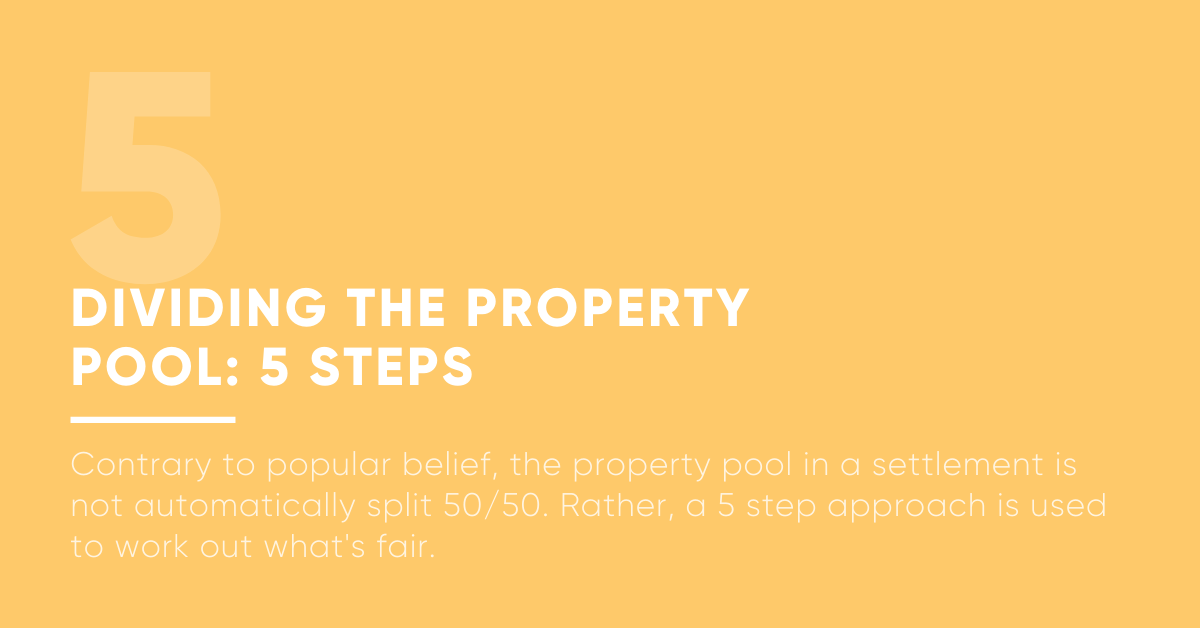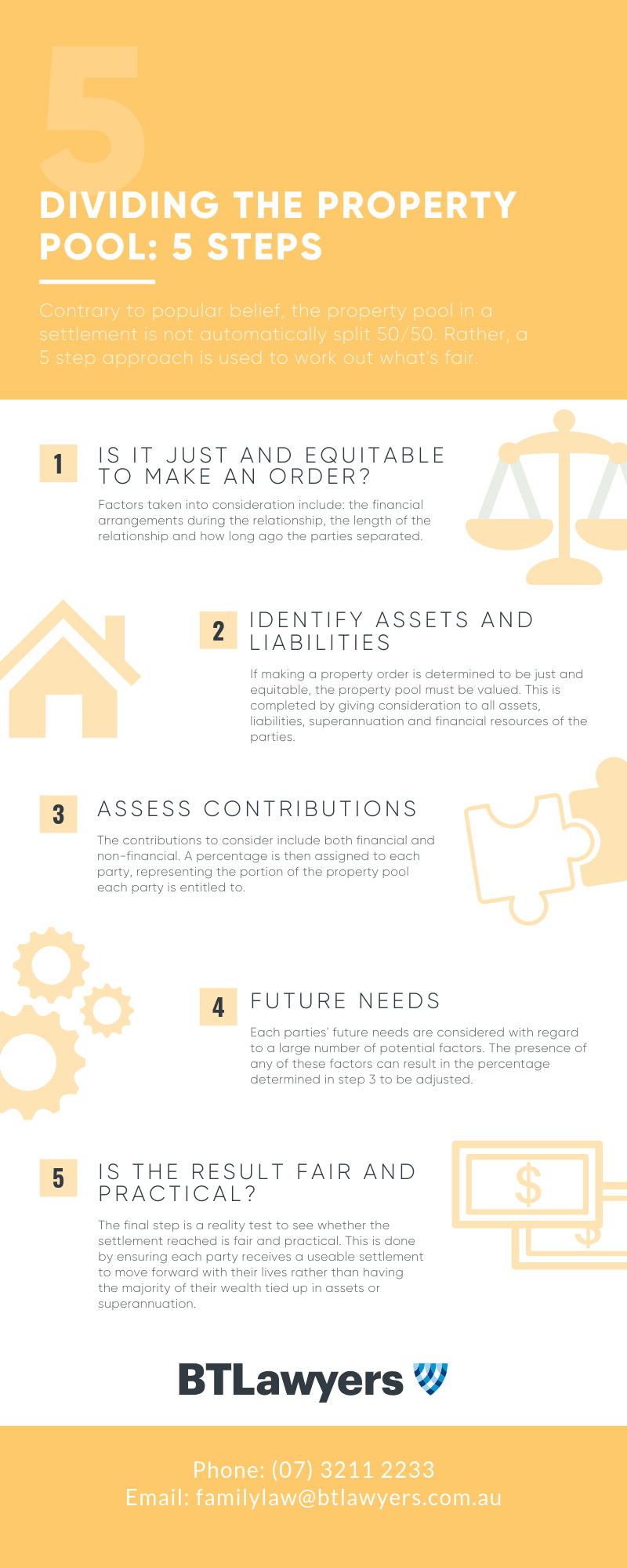Separating from your spouse or de-facto partner is one of the most emotional and stressful times in anyone’s life. Not only is the change in lifestyle difficult and upsetting, wondering how your property settlements are going to be finalised is often misunderstood, confusing and confronting.
A common misconception is the belief that all property settlements are split equally. Whilst this may be the starting point of consultation with BTLawyers, it is uncommon for property settlements to be finalised in this fashion.
There are two options when attempting to finalise your property settlement with your spouse or de-facto partner:
- By having your solicitor formalise the property agreement you and your partner have agreed to by way of consent; or
- By commencing proceedings in the Family Court of Australia.
Both options are guided by the same approach. This is known as the “5 Step Process”. At BTLawyers, we use the 5 Step Process when discussing your property matters in your initial consultation.
Infographic prepared by Lucy Agnew and BTLawyers.
Step 1: Whether it is Just and Equitable to make an Order in the First Place
The first step is to consider whether a property settlement is required. Property settlements are deemed to be “just and equitable” when both parties have voluntarily separated and no longer enjoy the common use of the parties’ assets. This will be the case in the vast majority of matters. However, in some circumstances, it may be more appropriate for each party to keep what they presently own. This includes, but is not limited to:
- You and your spouse kept your financial affairs and arrangements totally separate from one another during the relationship;
- The relationship was short in duration; or
- The parties are out of time to commence a property settlement. It is important to note that there are different time limits depending on the circumstances of your relationship so it is important you obtain legal advice as soon as possible.
Step 2: Identifying and Valuing the Assets and Liabilities of the Property
This step can be confronting to discuss with your solicitor. However, it is arguably the most important step in the process. Identifying and valuing the assets and liabilities involves creating a “property pool” for the relationship. This includes all assets, liabilities, superannuation and other financial resources held in either joint or sole names.
Whilst these values can be estimates, the more accurate the information you provide to your solicitor, the more accurate their advice can be in relation to what your entitlements should be. It is recommended you are prepared for any consultation with your solicitor by knowing the current amount or value of any: bank account (including credit cards and mortgages), real property, motor vehicles, loans (including personal loans, car finance or HECS debts) and any other items that would be included in the property pool. If you are unable to obtain the information for assets or liabilities in your spouse or partner’s name, we are able to obtain this information through the parties’ Duty of Disclosure. For more information in relation to your Disclosure Obligations, click here.
Step 3: Assessing the Contributions of Each Party
Once a property pool has been established, it is important to consider the financial and non-financial contributions each party made.
Firstly, initial contributions are assessed to determine whether one party came to the relationship with significantly more assets and liabilities than the other, or if the parties commenced building their wealth together. The financial and non-financial contributions made by each party during the relationship is taken into account. There are a wide variety of factors to be considered during this process. However, the most common factors include:
Financial Contributions:
- Salary from employment;
- Gifts or inheritances received;
- Compensation (such as WorkCover or a Personal Injury claim);
- Lotto winnings; and
- Claims of wastage
Non-Financial Contributions:
- Who was the primary carer of any children during the relationship;
- Who performed the domestic duties for the household; and
- Whether any renovations/improvements or maintenance work was conducted on the property by either party personally.
A percentage split (i.e. 50/50) is determined at the end of this stage.
Step 4: Assessing the “Future Needs” of the Parties
The next step is to assess the future needs of each party to determine if any adjustments to the determined percentage split need to be made.
The factors to be considered are listed in the Family Law Act 1975, however, these serve as a guide and are not exhaustive. Examples of what situations would support an adjustment include:
- The age of the parties. If there is a substantial difference in age meaning that the older party has less time to acquire income before retirement.
- The health of the parties. If one party has health problems, this might reduce their capability to work full-time or require expensive ongoing treatment.
- The earning capacity of the parties. If one party is on a significantly higher income, they are able to better support themselves and become financially dependent following the separation quicker than the other party
- If one party will have primary care of the children. This means that parent is restricted to the hours they are able to work and greater household expenses.
Once these considerations have been taken into account, the percentage split could be adjusted in favour of one party (i.e. 55/45).
Step 5: Determining if the Result is “Just and Equitable”
The last step serves as a reality test to ensure the determined percentage split (i.e. 55/45) is practicable in the circumstances. This is done by converting the percentage split into dollar amounts before applying it to the specific property pool of the party.
An example, where the result is not “just and equitable”, would be one party wanting to keep the former matrimonial home. In order to make this property settlement “just and equitable”, the party wanting to keep the house would be required to either give assets to or take liabilities from the other party until the agreed percentage split is reached.
Do you Feel Confused and Overwhelmed?
If you and your partner have separated and are finding it difficult to fairly divide your property and financial assets, and you are unsure of what time limits apply to your situation, BTLawyers are here to help. If you and your partner have been able to reach an agreement together, it is still recommended to have your agreement reviewed by a solicitor to ensure you receive what you are entitled to.
For further information, please call (07) 3211 2233, or complete the form below.







